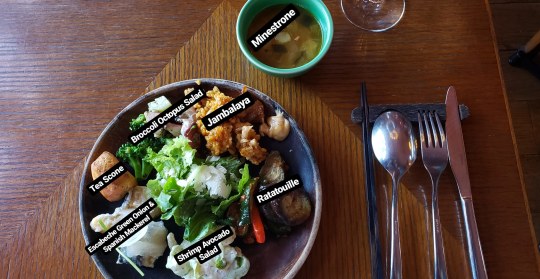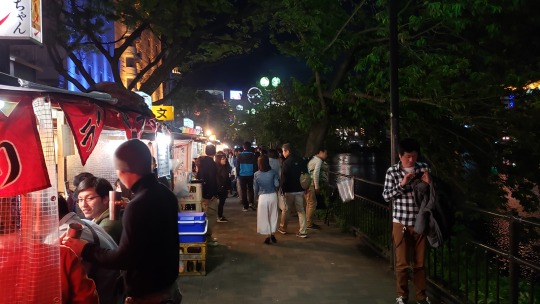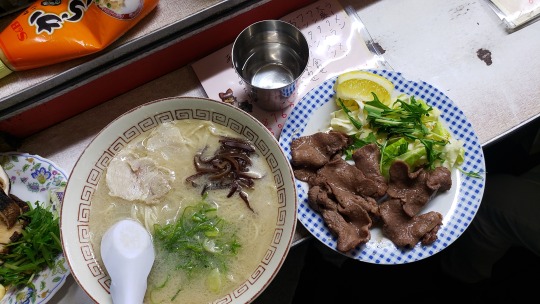#shiomidai
Explore tagged Tumblr posts
Text

2 notes
·
View notes
Photo

Shelterbelt, Shiomidai, Niigata, 2019 防砂林, 汐見台, 新潟, 2019
http://nanjotoshiyuki.com/shelterbelt http://nanjotoshiyuki.com/tagged/shelterbelt
57 notes
·
View notes
Photo

المشهد التقليدي لأسلوب الأناقة اليابانية الجميلة في متنزه شيوميداي في هيميجي #shiomidai #himejicastle #hyogoprefecture #japan https://www.instagram.com/p/B-HnRWZpSaG/?igshid=h7mzlokt4idp
6 notes
·
View notes
Text
Haruka, Nostalgia (はるか、ノスタルジー), 1993 dir. Nobuhiko Obayashi

status: complete download here
**translation notes: (contains spoilers)**
・The name of Shinsuke Ayase’s publisher, Lil’ Bunko, references the term bunko 文庫, short for bunkobon 文庫本, which are A6-sized softcover books - the most common format for novels. A lot of publishing companies in Japan use the word bunko at the end of their name.
・The term lolicon may not need explaining for many viewers of this film, but as I chose to translate it as a proper noun rather than directly translate it, I feel the need to provide a small explanation as it is quite central to the film’s plot. Lolicon is short for “Lolita complex”, and is used to refer to someone (usually male) that has a fetish for young (read: underage) girls.
・Some context is needed for the way the name Yoko Miyoshi is introduced and the influence it has on the story. The kanji for “Yoko Miyoshi” is 三好遥子, which can be broken down thus: 三-> the number 3, 好-> ‘like’ or ‘favorable’, 遥-> ‘distant’ or ‘far away’, as in the Japanese verb haruka, 子-> child. Haruka’s name is thus taken from the first half of “Yoko”, the kanji that when used on its own can be pronounced “Haruka”. Haruka plus the kanji for “child”, 遥子, can be interpreted as meaning “a distant/far away child”. I have attempted to include as much of this information in the subtitles as possible.
・nishin ニシン (鰊) is Pacific herring, and nishin-don is a local delicacy in Otaru. In reference to the dish, I have chosen to use nishin-don as a proper noun, but when Haruka tells the story of the herring that disappeared from the ocean, for clarity’s sake I chose to use ‘herring’ instead of nishin.
・A small aspect that gets lost in translation is the term Haruka uses to describe young girls as ‘passionate’ during her impassioned speech about Ayase’s behavior. She uses the term mune ga atsui 胸が熱い, which literally translates to “a hot chest/breast” - meaning that when someone gets worked up about something (mostly in a positive way), they feel a hotness in their chest. This coincides nicely with the ‘physical’ nature of her speech.
・Haruka mentions that the school song she sings is from her high school, Otaru Shiomidai, but in actual fact it is the real school song from Otaru Choryo High School (though the melody may not be identical). The school Haruka and Ayase visit together is not Shiomidai either - though Ayase mentions that he went to the same school as Haruka - it is Ishiyama Middle School.
・A note about the lines of dialogue in German: As verified by a native German speaker, Noboru’s German pronunciation is incredibly hard to decipher, and the lines seem to have been directly translated from Japanese by a non-native, riddled with incorrect grammar and strange vocabulary. As the most important parts of these lines are the Japanese sentences Noboru says after them, I have refrained from transcribing them for the subtitles; however a native German acquaintance was kind enough to help out with attempting to decipher them, so here is a bonus cheat sheet for the German dialogue: 1. 0:06:05 “Alles hat seine Zeit.” -> “Everything has its time.” 2. 0:39:16 "Der Mench ist, was er isst." -> “Man is what he eats.” 3. 0:40:44 "Mit der Habgier wird der Entfremdete immer eifersüchtig." -> “With greed, the alienated person is always jealous." 4. 0:43:45 “Kein Mädchen findet dich selb besser schön.” -> “No girl thinks herself more beautiful.” 5. 0:43:56 (also 1:00:09) "Wissen ist das Traurigste auf der Erde." -> “To know is the saddest thing on Earth.” 6. 0:46:10 "(Ich hätte) es leichter als (Mädchen)." -> “I think I had it easier as a girl.” (best guess) 7. 1:29:42 “Die (echte) liebe (verdreht) sich erst auf.” (?) -> “Real love twists first.” (who knows...) 8. 2:00:57 “Sie (endet?) über Fragen.” -> “She ends with questions.” ? 9. 2:25:17 “Alles hat seine Zeit. Nur endet sie nicht. Sie hilft nicht zu machen.” -> “Everything has its time. It just doesn’t end. It doesn’t help you to do/make it.”
・There are times when Ayase refers to Haruka as simply “Haruka”, and other times he adds “-chan” on to the end of her name. As many viewers may already be aware, “-chan” is an affectionate suffix often used for girls of a lower age than oneself, or somebody the speaker feels particularly friendly towards. Haruka’s comment about Ayase using “-chan” doesn’t carry as much meaning in English as it does in Japanese. Similarly, at one point Haruka remarks that Ayase has started using the personal pronoun ore 俺 instead of boku 僕 (or watashi 私 in his narrations, which is more reminiscent of the language used in a first-person novel). Ore is widely considered to be much more masculine than boku, so the subtitles reflect that nuance.
・The koto is a traditional Japanese stringed instrument, one of the most common sounds in Japanese music. It is often referenced to as a symbol of old-style Japanese romanticism, largely thanks to its presence in literature such as The Tale of Genji.
・Toward the end of the movie, Haruka muses to Hiroshi, “What is Haruka, I wonder?” The Japanese used for this line is ima no Haruka wa, ittai nan-nan deshou? 今のはるかは一体何なんでしょう? which directly translates to “What exactly is the Haruka of now/the present, I wonder?”. The line is meant to reflect several different things at once: Haruka’s confusion as to who she is, her role in Ayase’s story, and where she lines up with the criss-crossing of her (or Ayase’s) past and present. It is difficult to include all of those nuances, but I was intrigued by the way she used “what” instead of “who”, so I felt like “What is Haruka?” was a more concise way to reflect that line in English.
4 notes
·
View notes
Text
Japan Day 24
Today was the first day in a while I genuinely felt happy from morning to night (okay a few angry spikes but I was able to calm down pretty fast). I’ve been dreading this day honestly cause originally I was supposed to confront the issue when I headed to Hakata but it didn’t happen due to the other party and I was afraid of how heavy my heart would feel. But instead from the moment I woke up, I felt ready to tackle the world. I left Hiroshima today and took the Shinkansen down to Fukuoka. As I left Hakata station I was greeted by a farmer’s market, unfortunately they weren’t open yet and I didn’t think I’d get a chance to come back so I took as much of a look around the perimeter as I could. I headed to my dorm at The Life Hostel & Bar Lounge to drop off my stuff. I was greeted by the funniest employee. He was so elated when he heard I was from California and he kept giving me fist bumps. It was endearing. Once I dropped my things off I headed out for the day still trying to figure out what to do.
Despite everyone telling me to visit Ohori Park, I decided to go with my gut and go to a further location. The bus there was infrequent and long but I took my time strolling to the stop. On the way I passed by Kushida Shrine which had one of the most impressive displays I’ve seen yet at any shrine or temple

From there I continued my wandering and ended in the Hakata Old Town Area. I passed by the Hakata Traditional Craft and Design Museum which has free admission and some very informative and well-written displays about traditional Hakata textiles and doll design.

The centerpiece of the museum is this statute of the Fuku No Kami, a common motif of Hakata.
I continued to the bus stop and had the opportunity to explore the Kawabata Shopping Arcade. Their selection here is slightly different than other shopping arcades I’ve visited so I had a lot of fun exploring. I especially loved one shop that specialized in soy bean cosmetic goods and drinks. The amazake soy milk was so fresh and delicious. After the endless detours I did eventually make my way to the bus stop and to Uminonakamichi Seaside Park. I wasn’t quite sure where to go so I first headed left (facing Marine World) and ended up at a big empty green field by the water with an open BBQ restaurant connected to a small looking resort. I ended up going into The Luiganz resort for a delicous farm to table buffet lunch.


Gorgeous dining room with a view of their pool and some towering palm trees.


The selection was limited but the quality of the ingredients were excellent and the price was very reasonable at around $20.
After lunch I headed in the other direction and into the proper seaside park area. You can rent a bike for about $5 for the whole day and just bike this massive place. There’s so many paths I know I didn’t get to explore nearly all of them. There’s everything from a bird sanctuary to vast flower fields. Everything about the process was so simple.


Tons of gorgeous and fun spots but the best spot was definitely the

The Shiomidai Lookout where you can get a lovely panoramic view of the Genkai-nada Sea. There was just no one here and it was such a lovely place to unwind.
I’m not sure how long the entire bike ride was but it was definitely worth the pocket change. I took the railways back and ended up at Hakata Station where the Farmer’s Market was now in full swing.

I picked up some pre-dinner snacks and walked around before getting on the totally wrong bus and ending up in the Tenjin area. I walked around for a bit before finally heading back to my hotel to settle in so I could get going to the Yatai stalls by the river. The walk there was interesting since it’s through Hakata’s red light district. The place was crowded but not too too overrun. Most places didn’t have an English menu so I made a complete guess about where to eat but I chose the stall with the granny cooking because that’s where the best meals come from!



Such a fun experience getting crammed into a stall and trying to juggle your meal. Gorgeous river views too (if you’re willing to turn back and actually look at it).
I ended the night with a convenience store dessert before heading off to bed for my next big day.

All the extra little snacks I picked up on the way. I cannot stop eating here...
#Japan#Japanese Food#Food Blog#Food Blogger#Travel Blog#Travel Log#Travel Blogger#japanese#Asia#Asia Trip#Traveling Couch Potato#wanderl#explorepage#Hiroshima#japan tourism#nature#flowers#mobile photography#explore#explore food
15 notes
·
View notes
Photo

View site "Shiomidai" in Mt. Mineyama Shiomidai is carefully managed by those who love Mt. Mineyama. The summit climbs further east, but spends time here and descends south. The sea is good, but the mountains are also good.
0 notes
Photo

おはようございます。 #イマソラ はこんな感じ、今日も暑そうだ。。 #ひまわり #ヒマワリ#向日葵 #flower #yellow #sky #cloud #chigasaki #japan (湘南汐見台公園 Shonan Shiomidai Koen)
1 note
·
View note
Photo

昨日のランショットだけど ハイスペックなギアを装備してギター背負っている人がいた 日本中歩いてるのかな そういう旅もいいな (湘南汐見台公園 Shonan Shiomidai Koen)
0 notes
Photo

Shelterbelt, Shiomidai, Niigata, 2019 防砂林, 汐見台, 新潟, 2019
http://nanjotoshiyuki.com/shelterbelt http://nanjotoshiyuki.com/tagged/shelterbelt
15 notes
·
View notes
Photo

Shelterbelt, Shiomidai, Niigata, 2019 防砂林, 汐見台, 新潟, 2019
http://nanjotoshiyuki.com/shelterbelt http://nanjotoshiyuki.com/tagged/shelterbelt
14 notes
·
View notes
Photo

Shelterbelt, Shiomidai, Niigata, 2019 防砂林, 汐見台, 新潟, 2019
http://nanjotoshiyuki.com/shelterbelt http://nanjotoshiyuki.com/tagged/shelterbelt
9 notes
·
View notes
Photo

Shelterbelt, Shiomidai, Niigata, 2019 防砂林, 汐見台, 新潟, 2019
http://nanjotoshiyuki.com/shelterbelt http://nanjotoshiyuki.com/tagged/shelterbelt
7 notes
·
View notes
Photo

Mt. Mineyama Bamboo forest extending from Shiomidai to Yakumo Shrine I have an image of bamboo forest in Kamakura from novels and movies. It moves slowly in the wind here and there. There is a clicking sound.
0 notes
Photo

Exciting time Near Shiomidai Walkers and runners who passed each other at Mt. Mineyama were about half and half. It is a good hiking course with good running and a good view.
0 notes
Photo

Exciting time Above: Sunset on the Zaimokuza coast seen from Route 134 Lower right: Cape Inamuragasaki in Kamakura Lower left: Trail running near Shiomidai
0 notes
